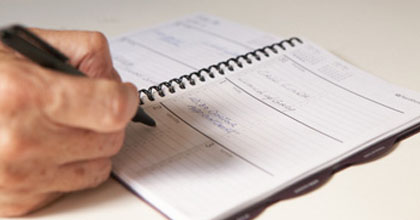
You can help your doctors help you by making sure they have the most accurate and up-to-date information about your health. Your do-to’s include making these lists and documents:
Medication List
Lists of Symptoms, Questions, Concerns
Personal Health Record
List of Care Providers
Medication List. This is a great tool to help you avoid any medication “misadventures,” and to make sure you are on top of what you’re taking. Make sure your doctor and pharmacist have the list, and that you keep a copy in your wallet or on your fridge in case of emergencies. The list should include all of the medications you are taking, prescription and over-the-counter, as well as herbs, vitamins and supplements:
- Your name and the date you are making (or updating) the list
- What you are taking (example: aspirin)
- How much (example: 1pill, 325 mg)
- How often (example: once per day)
- When and how (example: 8 a.m. with food)
- Why (example: headache) If you don’t know the reason, say so.
- The name and contact information of the doctor who prescribed the medicine.
Keep Track of Symptoms, Questions or Concerns. Make a list of what is wrong, has changed or is not normal for you (such as joint pain, trouble sleeping, dizziness, etc.), and when the problem started. Track your symptoms over time so you don’t forget. Also, make a note of anything you would like to talk about with your doctor, and what you would like out of the visit (a diagnosis, referral, records, etc).
Personal Health Record. This is one of the best ways for you to understand and be proactive about your own health, and to help your make a diagnosis or suggest a treatment. Include:
- Your Basic Information: Your name, birth date, contact information, the date you are writing the record, the name and contact information for your primary doctor and your emergency contact
- Health Alerts: This includes anything that will impact you in an emergency medical situation, such as an allergy to latex or penicillin; suffering from an illness, such as diabetes or Crohn’s Disease; having a medical device, such as a pace maker; and any prescriptions medications you are taking
- Current Health Status: This includes any illness you are suffering from or managing, any special diet or exercise program you might be on, any impairments, such as hearing loss or low vision, and the results of your most recent tests, such as your blood pressure
- Major Health Events: This is an overview of your health history, and includes things such as surgeries; broken bones; major illnesses, such as cancer; major events, such as childbirth or fertility issues
- Allergies: This should cover all allergies, such as rag weed, peanuts, latex
- Medical Devices: This can run the gamut from an artificial hip to a pacemaker to cochlear implants
- Your Family Health History: List anything that runs in your family (such as arthritis, diabetes or acne). This should include any major illnesses that an immediate relative (parents, siblings, children) or several relatives (cousins, aunts, nieces) suffer or died from.
List of Doctors and Pharmacist. Most people have more than one doctor and take at least 1 medication. It helps doctors to know who is treating you and for what. Make a list of your doctors (your “regular” doctor or internist, dentist, any specialist like a heart doctor, etc), and give it to each of them.
REMEMBER: Pack Up What You Need to Bring. Make three (3) copies of each list: for you, the doctor, and the front office, and remember to take them all with you when you go. Also, pack up whatever else you need: (insurance card, lab/medical reports, something to take notes with, a check or another way to pay for the visit or co-pay, films (X-Rays), DVDs (MRIs), etc.
